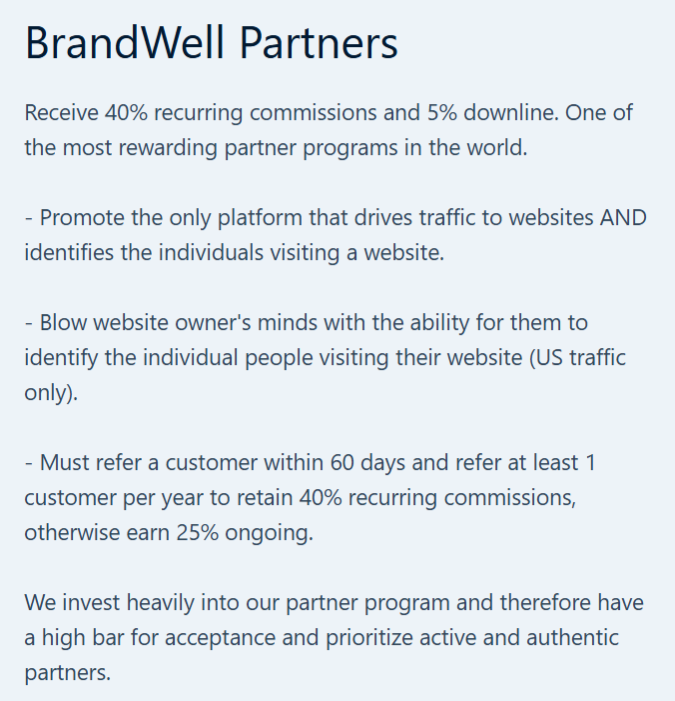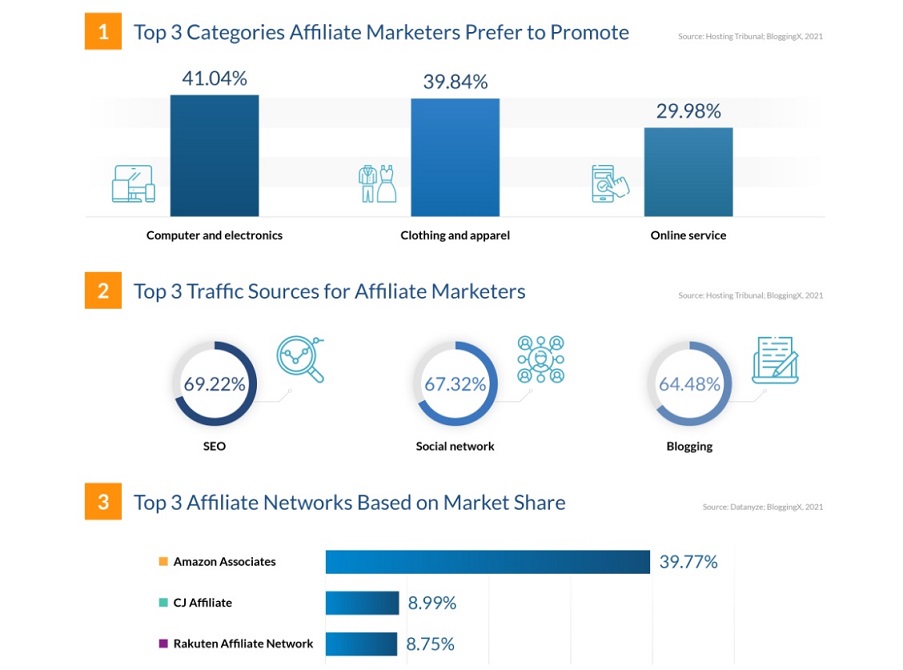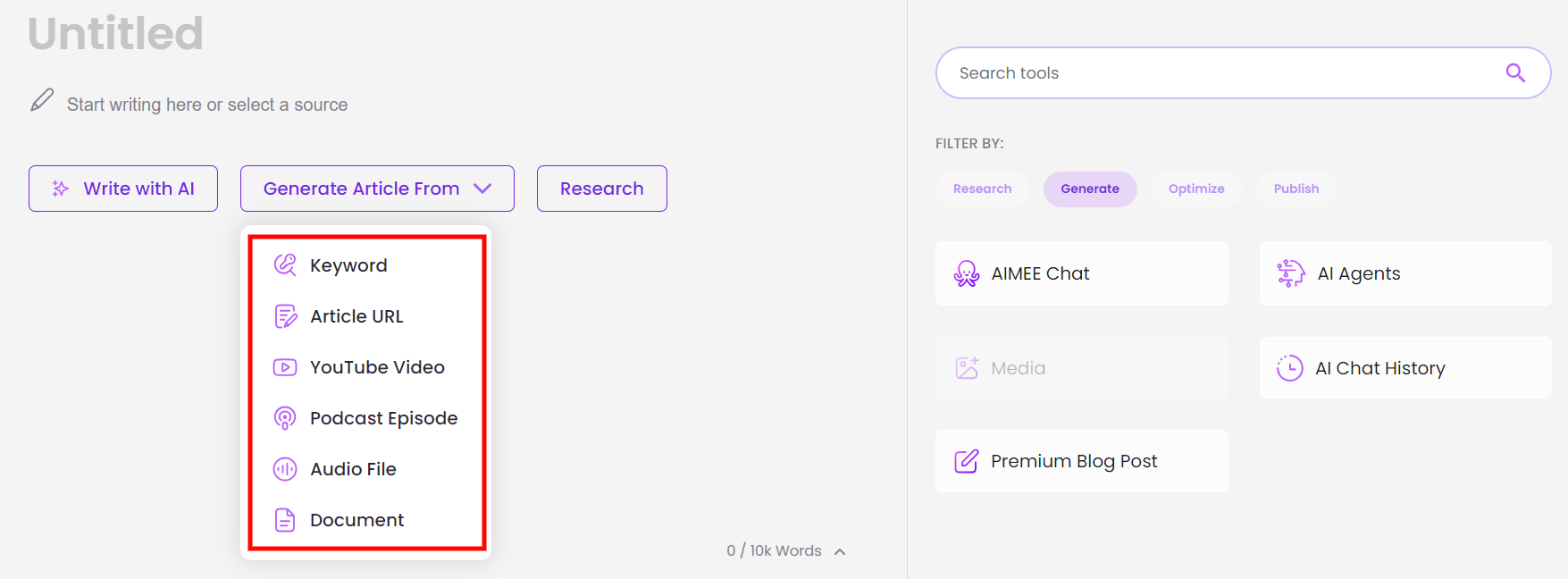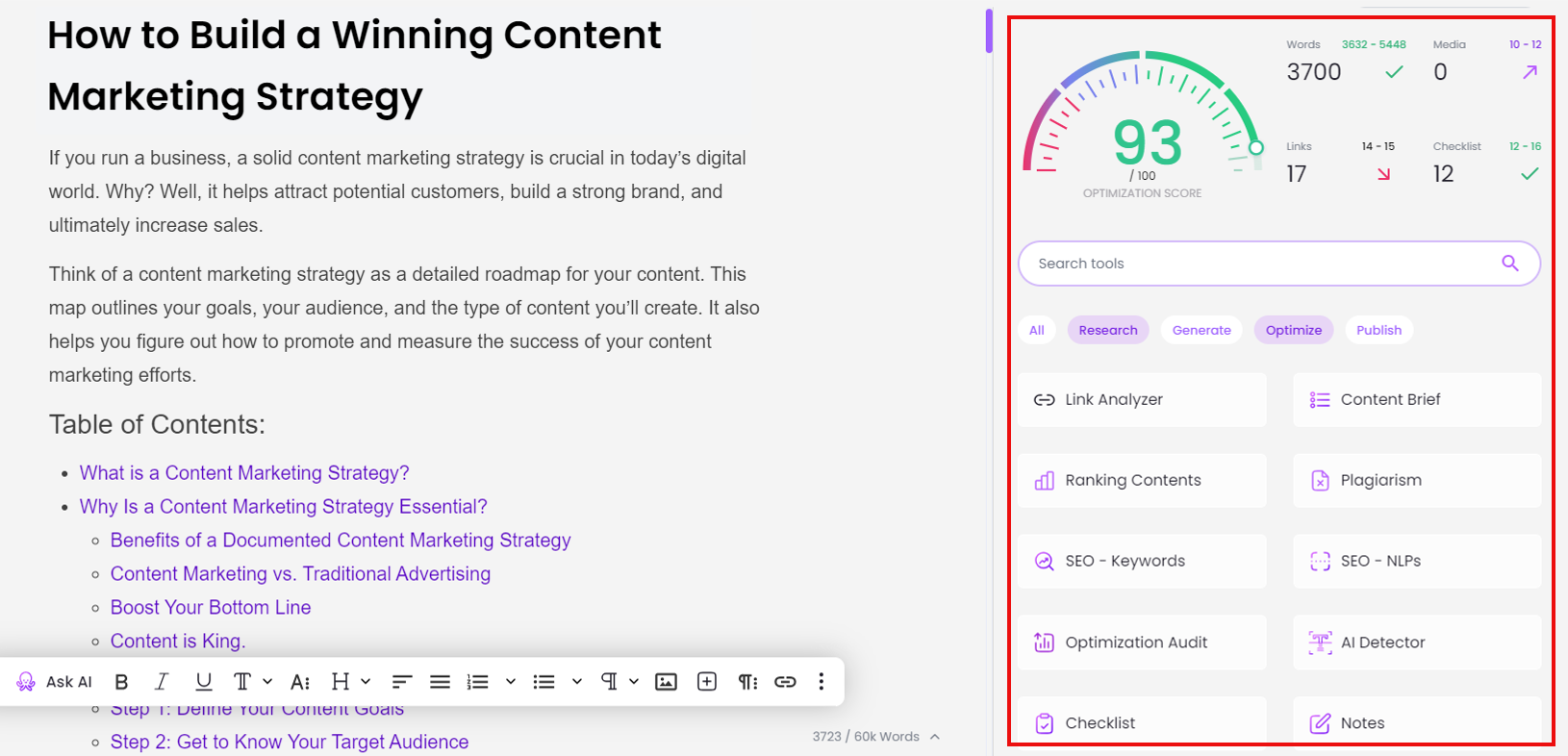Discover top guides, trends, tips and expertise from AIO Writers
How to Do Affiliate Marketing: A Complete Beginner’s Guide
Justin McGill
Thursday, 13th Mar 2025
Ever wonder how people make money online while they sleep?
You’ve probably heard about affiliate marketing, but maybe it seems too complicated — or worse, feels like a scam.
Here’s the problem: Most beginners dive in without a plan. They pick random products, post links everywhere, and hope for the best. But without the right strategy, they end up frustrated, making little to no money.
The good news? Affiliate marketing does work — if you do it the right way.
In this guide, I’ll show you how to choose a profitable niche, find the best affiliate programs, and create content that actually earns commissions. By the end, you’ll know how to build a real online income with affiliate marketing.
Let’s get started!
Table of Contents:
What is Affiliate Marketing?
Affiliate marketing is a way to make money online by promoting other people’s products.
When someone buys through your special link, you earn a commission. It’s like being a salesperson, but instead of knocking on doors, you use blogs, videos, or social media to recommend products you love.
Why is Affiliate Marketing a Great Way to Make Money?
✔️ Low startup costs – You don’t need to create a product, hold inventory, or deal with customer service.
✔️ Passive income potential – Once your content is out there, you can earn commissions while you sleep.
✔️ Work from anywhere – All you need is WiFi and a laptop.
✔️ Unlimited earning potential – The more quality traffic you get, the more you can earn.
Who is Affiliate Marketing For?
Affiliate marketing is perfect for:
- Bloggers who want to monetize their content.
- YouTubers who create reviews, tutorials, or product comparisons.
- Social media influencers who have an engaged audience.
- Email marketers who want to recommend helpful products to subscribers.
- Anyone willing to learn and put in the effort to build an audience.
The best part? You don’t need to be a tech genius or have a huge following to get started. With the right strategy, anyone can build a successful affiliate business.
Up next, let’s talk about how affiliate marketing actually works so you can see the full picture.
How Affiliate Marketing Works
Affiliate marketing might sound fancy, but it’s actually pretty simple. It’s all about connecting three key players:
- The Merchant (Seller/Brand) – The company that creates the product (e.g., Amazon, Nike, or a software company).
- The Affiliate (You!) – The person who promotes the product and earns a commission.
- The Consumer – The person who buys the product using your special link.
When you recommend a product and someone buys it through your affiliate link, you get a cut of the sale — without handling inventory, shipping, or customer service.
Here’s how affiliate marketing works, step-by-step:
- Join an Affiliate Program – You sign up for an affiliate program, like Amazon Associates, ShareASale, or a company’s direct affiliate program.
- Get Your Unique Affiliate Link – The program gives you a special link that tracks sales back to you.
- Promote the Product – You share the link on your blog, YouTube channel, social media, or email list.
- Someone Clicks & Buys – A visitor clicks your link and makes a purchase.
- You Earn a Commission – The merchant tracks the sale and pays you a percentage of the revenue.
How Affiliates Get Paid
Different programs have different ways of paying affiliates:
- Pay-per-sale (PPS) – You earn a commission when someone buys a product.
- Pay-per-click (PPC) – You get paid for sending traffic, even if no one buys.
- Pay-per-lead (PPL) – You earn money when someone signs up (e.g., for a free trial or email list).
How Do Companies Track Sales?
Every affiliate link comes with a tracking code. This tells the merchant that the customer came from you.
Some programs also use cookies, which track users for a set period (like 24 hours or 30 days). If they return and buy within that window, you still get credit for the sale!
Real-World Example
Let’s say you love fitness and write a blog about home workouts. You join Amazon’s affiliate program and recommend a set of dumbbells.
When a reader clicks your link and buys those dumbbells, Amazon pays you a small percentage of the sale — without you having to lift a finger (except to write your blog post).
Why This Model Works So Well
Affiliate marketing is a win-win for everyone because:
- Companies get more sales without spending on ads.
- Customers discover helpful products.
- You earn money for recommending things you believe in.
Now that you know how affiliate marketing works, the next step is choosing the right niche — because not all niches are equally profitable!

Screenshot from Finances Online
Choosing the Right Niche
Picking the right niche is one of the most important steps in affiliate marketing.
Choose wisely, and you’ll have an easier time making money. Pick the wrong niche, and you’ll struggle to get traffic or find good products to promote.
So, how do you choose a niche that’s profitable and enjoyable to work on?
First of all, what is a niche?
A niche is a specific topic or industry that you focus on. Instead of promoting random products, you build your content around a single theme that attracts the right audience.
For example:
✅ Good niche: “Home fitness for busy professionals” (specific and targeted)
❌ Bad niche: “Healthcare” (too broad and competitive)
How do you choose a good niche? 3 things to consider:
1️⃣ Demand – Are People Searching for It?
If no one is interested in your niche, you won’t make sales. Use tools like:
- Google Trends – See if interest is growing or declining.
- Keyword Research (Ubersuggest, Ahrefs, Semrush) – Check how many people search for topics in your niche.
- Amazon & YouTube – If there are bestselling books or popular videos on the topic, it’s a good sign!
💡 Example: “Eco-friendly home products” is a growing trend with increasing demand.
2️⃣ Profitability – Can You Make Money?
Some niches have a ton of interest but don’t pay well. Look at:
- Affiliate commission rates – Some programs pay 2% (Amazon), while others pay 30-50% (software products).
- Average product price – Selling a $20 product vs. a $500 product makes a big difference.
- Recurring commissions – Some programs (like web hosting and SaaS tools) pay you every month as long as the customer stays subscribed.
💡 Example: Fitness is a high-demand niche, but instead of promoting cheap resistance bands, you could promote premium treadmills (under-desk treadmills are hot right now!), fitness apps, or online coaching services.
3️⃣ Passion & Knowledge – Will You Stick With It?
Affiliate marketing isn’t a get-rich-quick scheme. It takes time to grow, so pick a niche you actually enjoy. If you hate the topic, you’ll burn out.
Ask yourself:
Do I already know about this topic, or am I excited to learn?
Could I create content on this for the next 6-12 months?
Is there an active audience I can engage with (forums, social media, YouTube)?
💡 Example: If you love gaming, you could focus on “best gaming accessories for streamers” instead of general gaming.
Examples of Profitable Affiliate Niches
Not sure where to start? Here are some of the best niches for affiliate marketing:
✔️ Evergreen Niches (Always in Demand)
- Health & Fitness (home workouts, supplements, weight loss)
- Finance (investing, credit cards, budgeting)
- Tech & Gadgets (laptops, software, smart home devices)
- Beauty & Skincare (organic beauty, anti-aging, men’s grooming)
- Online Business (freelancing, e-commerce, blogging)
✔️ Trending Niches (Growing Fast)
- AI tools & automation software
- Eco-friendly & sustainable products
- Remote work tools & digital nomad lifestyle
- Smart home & IoT devices
- Crypto & Web3 investments
Before going all in on a niche, do a quick test:
- Search for affiliate programs in that niche.
- See if blogs, YouTube channels, and influencers are making money in it.
- Check if you can consistently create valuable content on the topic.
If the answer is yes to all three, then you’ve found a solid niche!

Finding Affiliate Programs to Join
Now that you’ve picked your niche, it’s time to find affiliate programs that will actually pay you for promoting their products.
But with thousands of options out there, how do you choose the best ones?
Let’s break it down step by step.
Types of Affiliate Programs
There are two main ways to find affiliate programs:
1️⃣ Affiliate Networks (Multiple Brands in One Place)
Affiliate networks act as a middleman between affiliates (you) and companies. Instead of signing up for dozens of programs separately, you can manage everything in one place.
Pros:
✅ Access to hundreds (or thousands) of brands.
✅ One dashboard to track your earnings.
✅ Reliable payouts and customer support.
Cons:
❌ Some networks have strict approval processes.
❌ Lower commissions for some products.
Popular Affiliate Networks:
- Amazon Associates – Huge product selection but low commissions.
- ShareASale – Great for lifestyle, fashion, and home brands.
- CJ Affiliate (Commission Junction) – Ideal for established brands.
- Rakuten Marketing – Trusted by global companies.
- Impact – Great for high-ticket affiliate offers.
* Scroll down to read our review of the 5 Best Affiliate Networks. *
2️⃣ Direct Affiliate Programs (Company-Run)
Some brands run their own affiliate programs outside of networks. These programs often offer higher commissions and better support.
Pros:
✅ Higher payouts than networks.
✅ Direct relationship with the company.
✅ Exclusive perks (bonuses, discounts, free products).
Cons:
❌ You have to apply to each program separately.
❌ Tracking and payments vary by company.
Popular Direct Affiliate Programs:
Web Hosting (Great for Bloggers & Business Owners)
- Bluehost (up to $65 per signup)
- SiteGround (up to $100 per signup)
Online Courses & Education
- Udemy (varies by course)
- Coursera (fixed commission per signup)
E-commerce & Physical Products
- Shopify (affiliate program for online store owners)
- REI (outdoor gear, 5-10% commission)
Software & Online Tools (High Recurring Commissions)
- BrandWell (content marketing platform, 40% recurring commissions and 5% downline)
- Kit (email marketing, 30% recurring commission)

Discover How to Make Real Money on BrandWell’s Affiliate Program
How to Choose the Right Affiliate Program
Not all affiliate programs are worth your time. Here’s what to look for:
✔️ Reputation & Trustworthiness – Does the brand have good reviews? Do customers love their products?
✔️ Commission Rates – Higher commissions mean more money for you. Look for programs that pay at least 10-30% (or have high-ticket products).
✔️ Cookie Duration – A longer cookie window means you still get credit if someone buys later (Amazon’s cookie lasts 24 hours, but some programs last 30-90 days).
✔️ Payout Methods & Minimums – How and when do they pay? Some programs require you to reach $100+ before you get paid.
✔️ Recurring vs. One-Time Commissions – Subscription-based services (like SaaS tools) pay you every month, while physical products usually pay once.
How to Find Affiliate Programs in Your Niche
If you’re unsure which affiliate programs exist in your niche, try these methods:
Google Search: Search “[your niche] + affiliate program” (e.g., “best fitness affiliate programs” or “tech affiliate programs”).
Check Competitor Websites: Find blogs or YouTubers in your niche and see what products they promote. Many list their affiliate links in reviews or “Recommended Tools” pages.
Visit Brand Websites: Many companies have a dedicated “Affiliate” or “Partners” page at the bottom of their website.
Next Steps: Apply & Get Approved
Once you’ve found good affiliate programs, it’s time to apply! Here’s how to increase your chances of approval:
✔️ Maintain a blog, YouTube channel, or social media presence.
✔️ Show that you can drive traffic and sales (even if you’re new, explain your content strategy).
✔️ Follow the program’s rules (some restrict PPC ads or specific promotional methods).
Once you’re approved, you’ll get your unique affiliate link — which means you’re officially ready to start promoting!

Building a Platform for Affiliate Marketing
Now that you’ve picked a niche and joined affiliate programs, it’s time to build a platform where you can share your affiliate links and attract an audience.
Your platform is where people discover your content, trust your recommendations, and — most importantly — click on your affiliate links. The stronger your platform, the more money you can make.
Affiliate marketers use different platforms to promote products. Here are the top choices:
1️⃣ Blogging (Best for SEO & Long-Term Growth)
A blog is one of the best platforms for affiliate marketing because it allows you to create evergreen content that ranks on Google and brings in free traffic for years.
Pros and cons:
✅ Long-term traffic, passive income, and full control.
❌ Takes time to rank and requires writing skills.
How to Start a Blog for Affiliate Marketing:
- Pick a domain name (GoDaddy, Namecheap).
- Get hosting (Bluehost, SiteGround).
- Install WordPress and choose a clean, fast-loading theme.
- Write content that naturally includes affiliate links.
2️⃣ YouTube (Best for Reviews & Demonstrations)
If you’re comfortable on camera, YouTube is a goldmine for affiliate marketing.
Pros and cons:
✅ Video content ranks in Google, builds trust quickly, and has viral potential.
❌ Requires video editing skills and equipment.
How to Start a YouTube Channel for Affiliate Marketing:
- Pick a niche and content style (tutorials, product reviews).
- Film and edit with tools like DaVinci Resolve or Adobe Premiere Pro.
- Optimize video titles and descriptions and include affiliate links.
- Encourage viewers to click your links in the description.
3️⃣ Social Media (Best for Quick Engagement)
Social media is great for reaching people fast and building an audience.
Pros and cons:
✅ Quick exposure, easy to start, no website required.
❌ Requires frequent posting, algorithm changes can impact reach.
Best Platforms for Affiliate Marketing:
- TikTok & Instagram Reels – Short, engaging product demos.
- Pinterest – Drives traffic to blog posts.
- Facebook Groups – Build a community and recommend products.
- Twitter/X – Share insights, threads, and product links.
💡 Some platforms don’t allow direct affiliate links. Use a link-in-bio tool like Linktree or a simple landing page.
4️⃣ Email Marketing (Best for Long-Term Conversions)
Your email list is an asset you own — no algorithm can take it away.
Pros and cons:
✅ Direct access to your audience, better conversion rates.
❌ Takes time to grow.
How to Build an Email List for Affiliate Marketing:
- Create a freebie (ebook, checklist) to encourage sign-ups.
- Use email marketing tools (Kit, MailerLite).
- Send valuable content before promoting affiliate products.
- Set up automation sequences to nurture leads.
Creating High-Converting Content
Your platform is built, but now comes the most important part — creating content that actually gets clicks and generates affiliate sales.
Just throwing affiliate links into random content won’t work. You need to strategically create content that drives action.
Step 1: Understand Buyer Intent
Not all website visitors or video viewers are ready to buy. Some are just researching, while others are ready to pull out their credit cards.
Here’s how to match content types to buyer intent:

💡 Focus on decision-stage content first (reviews, comparisons). These visitors are more likely to click and buy.
Step 2: Best Types of Affiliate Content & How to Create Them
Now let’s break down what works and how to do it right:
1️⃣ Product Reviews (Best for Decision-Stage Buyers)
People searching for “[Product Name] Review” are already interested and looking for an honest opinion.
How to Write a High-Converting Review:
- Test the Product – Use the product yourself (or research it deeply).
- Be Honest – Share pros & cons (people trust balanced reviews).
- Highlight Key Features – Explain why they matter.
- Compare to Alternatives – Show why it’s better (or worse) than the competition.
- Include a CTA – Example: “👉 Click here to get the best deal on [Product]“
Example Headline: “Is [Product] Worth It? My Honest Review After [X] Days”
2️⃣ Comparison Posts (“X vs. Y”)
Buyers love side-by-side comparisons to see which product is better.
How to Write an Effective Comparison:
- Pick Two Similar Products – Example: “iPhone 16 vs. Samsung Galaxy S24”
- Compare Key Features – Price, ease of use, features, pros & cons.
- Add a Recommendation – Help readers decide which one suits their needs.
- Use Tables for Clarity – Visuals make it easier to digest.
Example Headline: “iPhone 16 vs. Google Pixel 9: Which One Should You Buy?”
3️⃣ Best-of Lists (“Top X Products for Y”)
People searching for “Best [Product] for [Use Case]” are actively looking to buy but want options.
How to Write a High-Converting Listicle:
- Choose a Specific Niche – Example: “Best Microphones for YouTube in 2025”
- List the Top Options – Give 5-10 choices.
- Include Pros & Cons – Make decision-making easy.
- Use an Affiliate CTA – Example: “Check the latest price here.”
Example Headline: “Best Laptops for Video Editing in 2025 (Tried & Tested)”
4️⃣ How-To Guides (Educational Content That Sells Softly)
How-to guides attract top-of-funnel traffic (awareness stage) and introduce people to affiliate products naturally.
How to Write an Effective How-To Guide:
- Solve a Problem – Example: “How to Build a Website in 10 Minutes.”
- Walk Readers Through the Steps – Use screenshots, videos, or GIFs.
- Recommend Affiliate Products – Example: If you’re teaching website building, recommend Bluehost hosting.
Example Headline: “How to Start a Blog in 2025 (Step-by-Step Guide)”
Step 3: Make Your Content More Engaging
✔️ Use Clear, Simple Language – Write at an 8th-grade level so everyone understands.
✔️ Add Visuals – Use images, GIFs, and videos for better engagement.
✔️ Place Affiliate Links Naturally – Don’t spam. Add them where they make sense.
✔️ Use Strong CTAs – Tell your audience why they should click your link and what’s in it for them. Example: “Grab the best discount on [Product] here.”
💡 Don’t just write content — update it regularly to keep it fresh! Google and readers love updated posts.
Generating Traffic to Your Affiliate Content
Creating content is just half the battle. Now, you need traffic — because no visitors = no sales.
Step 1: Free (Organic) Traffic Strategies
If you’re on a budget, start with free traffic sources that bring in visitors without paying for ads.
1️⃣ SEO for Blogs & YouTube
- Find Low-Competition Keywords – Use tools like Ahrefs, Ubersuggest, or Google’s autocomplete.
- Write Longer, More In-Depth Posts – Google loves detailed content.
- Use Keywords in Your Title & Headings – Example: Instead of “My Favorite Laptops,” write “Best Laptops for Video Editing in 2025.”
- Optimize for Featured Snippets – Answer common questions clearly and concisely in your content.
2️⃣ Pinterest (Great for Blog Traffic)
Pinterest is not just a social media platform — it’s a search engine!
How to Use Pinterest for Affiliate Marketing:
- Create Click-Worthy Pins – Use Canva to design eye-catching images.
- Write Keyword-Rich Descriptions – Example: “Best budget laptops for students in 2025.”
- Pin Consistently – Use Tailwind to schedule posts.
- Link Pins to Your Blog Posts – Never direct-link affiliate links (Pinterest doesn’t like that!).
3️⃣ Social Media (For Quick Engagement)
Use Instagram, TikTok, and Facebook to drive traffic.
How to Promote Affiliate Content on Social Media:
- Post Short-Form Videos – Reels, TikToks, and YouTube Shorts get massive reach.
- Share Value Before Selling – Teach something, then recommend a product.
- Link to Your Blog or Landing Page – Don’t drop affiliate links randomly!
Example: Post a 30-second TikTok video showing “5 AI Writing Tools That Save You Time” with a link in your bio.
Step 2: Paid Traffic Strategies (Faster Growth)
Once you make some affiliate sales, reinvest into paid traffic to scale faster.
1️⃣ Google Ads (For High-Intent Buyers)
- Run ads targeting buyer-intent keywords (e.g., “Best Laptops Under $1000”).
- Direct traffic to a blog post (not the affiliate link directly).
- Use retargeting ads to bring visitors back.
2️⃣ Facebook & Instagram Ads (Great for Lead Generation)
- Offer a free lead magnet (e.g., “Free Guide to Weight Loss Supplements”).
- Capture emails, then promote affiliate products via email marketing.
💡 Never direct-link affiliate products in Facebook Ads — your ad might get banned!
Scaling Your Affiliate Marketing Business
So you’ve set up your platform, created high-converting content, and are starting to generate traffic. The next step is to boost your conversion rates and increase commission earnings to turn affiliate marketing into a full-time income.
Step 1: Optimize Your Conversion Rate (More Clicks, More Sales)
Getting visitors to your content is one thing, but getting them to click your affiliate links and make a purchase is where the money is made.
1️⃣ Improve Your CTAs
A weak call to action = lost commissions.
Instead of saying “Check this out”, try:
- An urgency-based CTA: “Get this deal before it’s gone!”
- A benefit-driven CTA: “Save 30% on [Product] today!”
- A comparison CTA: “See how [Product] stacks up against competitors.”
💡 Place your main CTA above the fold so it’s visible without scrolling.
2️⃣ Add More Clickable Links
Many readers skim instead of reading, so make it easy for them to find your affiliate links.
- Use buttons for high visibility
- Link inside images (for blogs)
- Mention links naturally in YouTube videos & captions
3️⃣ Build Trust with Your Audience
People buy from those they trust. Here’s how to boost your credibility:
- Be Transparent – Mention that you earn a commission (it’s also legally required).
- Show Proof – Screenshots, results, case studies.
- Avoid Over-Promoting – Too many links = spammy & untrustworthy.
Examples:
Personal Experience: “I’ve used [Product] for 6 months—here’s what I love.”
Social Proof: “Over 10,000 people use this tool—here’s why.”
Step 2: Increase Affiliate Commissions (Make More Per Sale)
Making more money per sale means you can scale faster with less traffic.
1️⃣ Choose High-Paying Affiliate Programs
Not all programs pay equally. Instead of Amazon Associates (low commissions), try:
Digital Products (30-50% commissions)
- Online courses (e.g., Udemy, Teachable)
- SaaS tools (e.g., Semrush, Kit)
Recurring Commission Programs
- Marketing tools (e.g., ActiveCampaign, BrandWell)
- Hosting platforms (e.g., Bluehost, Kinsta)
Promoting a SaaS tool like BrandWell which pays a 40% recurring commission means if you get 100 people to sign up, you earn monthly passive income.
2️⃣ Negotiate Higher Commissions
If you’re driving consistent sales, many programs will increase your commission rates — you just have to ask.
- Email the affiliate manager.
- Show your conversion rate & traffic data.
- Ask if they can offer a higher tier commission.
Example Email Template:
“Hi [Affiliate Manager],
I’ve been promoting [Product] and driving consistent sales. My audience responds well to it, and I’d love to scale up. Is there an opportunity to increase my commission rate?”
💡 Brands love high-converting affiliates, so if you’re sending sales, you have leverage.
Step 3: Scale Your Affiliate Marketing Business
Once you have consistent commissions, it’s time to scale!
1️⃣ Automate with Email Marketing
Instead of relying only on blog or social media traffic, build an email list and nurture leads automatically.
- Offer a Freebie – Create ebooks, guides, or checklists.
- Use an Email Funnel – Start with value, then introduce affiliate products.
- Send Consistent Emails – Weekly recommendations or exclusive deals.
💡You can automate your email content with a tool like BrandWell. Watch how:
2️⃣ Outsource & Expand Content Production
More content = more traffic = more sales.
But you don’t have to do it alone. You can:
- Hire writers (for blog content).
- Use AI writing tools (like BrandWell).
- Hire a video editor (if you’re on YouTube).
💡 If you’re already making around $3,000+ per month, consider investing in a content marketing platform like BrandWell. For only $249 per month, you can scale your content production by up to 25X! See how one of our clients, Journey Engine, did it:
3️⃣ Try Paid Ads (Only If Profitable)
Once your affiliate business is profitable, you can start running paid ads so you can grow faster.
- Run Retargeting Ads – Show ads to people who have visited your content.
- Use Google Search Ads – Target “buying intent” keywords (e.g., “Best laptop for students 2025”).
- Test Small First – Start with $10-$20/day, optimize, then scale.
Now, the final step is to stay consistent. Affiliate marketing isn’t an overnight success game — but with persistence, you can build a passive income machine that pays for years. 🚀

5 Best Affiliate Marketing Networks
Looking for programs that are easy to use and offer the best affiliate commissions? Check out these popular affiliate networks.
1. Amazon Associates
If you’re looking to start affiliate marketing, one of the most well-known and lucrative platforms is Amazon Associates.
Amazon allows you to promote any product available on its site, making it a versatile choice for many bloggers regardless of their specific content focus. From books and electronics to fashion items and home goods, there’s likely an affiliate product relevant to your audience.
When someone clicks on an Amazon link from your blog post and makes a purchase within 24 hours, you earn a commission ranging from 1% up to 10%, depending upon the category of the product.
A key aspect of successful affiliate marketing strategies involves effectively promoting products that resonate with your readership. This could involve writing detailed product reviews, listicles, or tutorial-style posts showcasing how particular products can be used.

2. Shopify Affiliate Program
Another profitable option is Shopify. This affiliate program offers a unique opportunity for bloggers, influencers, educators, and other content creators to earn money by promoting Shopify’s e-commerce platform.
The primary way you can make money through this affiliate program is by referring new users to Shopify. For each referral that signs up for a paid plan, you receive an affiliate commission. The amount varies depending on which subscription plan your referral chooses but it can be quite substantial.

3. Rakuten Marketing
Rakuten Marketing is one of the best affiliate programs to join. With more than 1,000 merchants, you’ll find products from industry giants like Sephora, Virgin Holidays, New Balance, and DialogTech.
The user interface is simple and easy to navigate and their help center offers great resources for beginners. Plus, with a generous commission rate on sales, it’s no wonder why so many bloggers are signing up.

4. ShareASale
With over 4,000 merchants and some paying up to $300 per sale, ShareASale stands out as an excellent option when it comes to making money blogging. It has fewer top-tier brands but makes up for it with its search parameters such as EPC Greater Than or Commission Rate Greater Than filters. This makes it easier for bloggers to identify lucrative opportunities for generating affiliate income.
Additionally, they have a two-tier program filter that shows which products enable you to earn a commission from sub-affiliate referrals too. Another plus point for those who are considering affiliate promotions.

5. Creative Market
For those targeting creative professionals, Creative Market could be just what they need when looking for affiliate income. They specialize in photos, graphics, and WordPress themes and offer a 15% commission on a customer’s first purchase – ideal if your readers are always searching for new design elements online.
You’ll earn a 15% cut of any new customer’s first purchase, and a 5% cut of any returning customer’s purchase made within 30 days of clicking on your referral link.
A great strategy here would be bundling items together in content pieces so customers buy multiple items at once – boosting initial purchases considerably.

Common Mistakes to Avoid in Affiliate Marketing
Even the best affiliate marketers started as beginners, making plenty of mistakes along the way. The good news? You don’t have to learn the hard way.
Let’s go over some of the most common pitfalls and how to avoid them like a pro.
Promoting Too Many Products at Once
It’s tempting to sign up for every affiliate program and start promoting dozens of products at once. After all, more products mean more chances to earn, right?
Not exactly. Spreading yourself too thin makes it harder to create focused, high-quality content that actually converts.
Instead, start small. Choose a specific niche and focus on a few strong products that align with your audience’s needs. This way, you can go deeper with your recommendations, build trust, and see better results.
Choosing the Wrong Products
Affiliate marketing is all about recommendations, and if you push low-quality or irrelevant products, your audience will lose trust fast.
Some products might offer huge commissions, but if they aren’t useful, they won’t sell — and worse, they could hurt your reputation.
The key is to promote only products you believe in. If possible, test them yourself, read customer reviews, and make sure they solve a real problem for your audience.
A great product practically sells itself — you’re just making the introduction.
Ignoring SEO
You can write the most helpful affiliate content in the world, but if no one finds it, it won’t make you a dime. Many beginners overlook SEO, which means they miss out on free, long-term traffic from Google.
To fix this, focus on keyword research — find phrases your audience is already searching for.
Optimize your content by using clear headings, meta descriptions, and internal links. The better your SEO, the more visitors — and potential buyers — you’ll attract.
Skipping Email Marketing
Many affiliate marketers rely only on blog traffic or social media, forgetting about one of the most powerful sales tools — email marketing.
Unlike social media (where your posts disappear in a day), emails let you stay in direct contact with your audience.
Start building an email list as soon as possible. Offer something valuable — like a free guide or exclusive tips — to encourage sign-ups.
Once you have an engaged email list, you can send helpful content, special deals, and affiliate product recommendations directly to their inbox.
Overloading Content with Affiliate Links
Affiliate links are your money makers, but stuffing too many into your content can feel spammy and turn readers away.
If every sentence has a link, people might feel like they’re being sold to, rather than helped.
The trick is balance. Instead of flooding your content with links, place them naturally within helpful sections.
Use clear call-to-actions like “Check out my full review here” or “Get 10% off with this link.”
The goal is to make clicking feel like a natural next step, not a sales pitch.
Forgetting to Disclose Affiliate Links
It’s not just good practice to disclose affiliate links — it’s a legal requirement in many places (including the U.S.).
Failing to tell your audience that you earn a commission from your recommendations can break trust and even get you into trouble.
The fix is easy: be transparent.
Add a simple disclosure at the start of your blog post, video, or social media post. Something like:
“This post contains affiliate links. If you purchase through these links, I may earn a commission at no extra cost to you. I only recommend products I trust.”
Being upfront with your audience builds credibility — and they’ll appreciate your honesty.
Expecting Overnight Success
A lot of people get into affiliate marketing expecting to make quick money, but the reality is, it takes time and consistency to see results.
If you don’t make money in your first month (or even the first few months), that doesn’t mean you’ve failed — it just means you need to keep going.
The best approach is to treat affiliate marketing as a long-term business. Set realistic goals, track your progress, and continuously refine your strategies.
The more content you create, the more traffic you attract, and the more sales you generate.
Affiliate marketing is not about luck — it’s about strategy. By avoiding these common pitfalls, you’ll be on your way to consistent affiliate earnings and a thriving online business! 🚀
Automate Your Affiliate Marketing Content
Creating top-quality content to promote affiliate products or services is the best way to generate affiliate sales. But researching, writing, and editing blog posts every single day can be challenging.
This is where marketing automation technology can help.
Artificial intelligence makes your job much easier by generating blog posts within minutes instead of hours! With a content marketing platform like BrandWell, you can leave the heavy lifting to AI — all you have to do is input your target keyword (or URL) into the app and let the machine do its work.

Once your first draft is ready, you can start giving your blog post some love, adding that human touch that appeals to your audience.
Go through the built-in SEO tools on the right sidebar to make sure your work is optimized and then hit Publish to post your article directly to WordPress. 
FAQs – How to Do Affiliate Marketing
How can I start affiliate marketing as a beginner with no money?
You can start affiliate marketing for free by leveraging organic traffic and free tools. Here’s how:
- Choose a niche – Find a topic you’re passionate about, like health, tech, or finance.
- Sign up for free affiliate programs – Amazon Associates, ClickBank, and ShareASale accept beginners.
- Create a free website or blog – Use platforms like WordPress.com, Blogger, or Medium.
- Use social media marketing – Promote your affiliate links on YouTube, TikTok, Instagram, or Facebook groups.
- Leverage SEO for free traffic – Write blog posts or answer questions on Quora and Reddit to get organic traffic.
💡 Tip: Start with product reviews and “best of” lists — these convert well!
How do I become an affiliate marketer without a website?
You can do affiliate marketing without a website by using alternative platforms:
- YouTube – Create product reviews and tutorials with affiliate links in the description.
- TikTok & Instagram Reels – Short-form videos showcasing products can drive conversions.
- Email Marketing – Build an email list with a free lead magnet and send recommendations.
- Pinterest – Pin affiliate product images with engaging descriptions.
- Facebook Groups – Provide value and recommend products within niche communities.
💡Tip: Use free blogging platforms like Medium or LinkedIn to create content without managing a website.
Can I start affiliate marketing with no experience?
Yes, you can start affiliate marketing with zero experience! Here’s a beginner-friendly roadmap:
- Learn the basics – Watch YouTube tutorials or take free courses on Udemy.
- Pick a beginner-friendly niche – Tech accessories, fitness gear, or digital products work well.
- Choose easy-to-join programs – Amazon Associates, Rakuten, and ShareASale require no prior experience.
- Create content – Start with simple blog posts, social media reviews, or comparison videos.
- Drive traffic – Focus on SEO, Pinterest, and social media marketing.
💡Tip: Stick with one platform first — don’t overwhelm yourself with multiple strategies!
Can you really make $500 a day with affiliate marketing?
Yes, but earning $500 per day in affiliate marketing requires:
- High-ticket affiliate programs – Promote software, courses, or services with big commissions.
- Evergreen blog content – SEO-optimized posts that rank for high-converting keywords.
- Email marketing – Build a subscriber list and send regular promotions.
- Paid ads – Run Facebook, Google, or YouTube ads for faster conversions.
- Affiliate sales funnels – Use landing pages and automated email sequences to nurture leads.
💰 Strategy: If you promote a $100 commission product, you only need 5 sales per day to hit $500!
How long does it take to make money with affiliate marketing?
Making money with affiliate marketing depends on your strategy and effort:
- 1–3 months – Beginners start seeing small commissions ($50–$200/month) from organic content.
- 3–6 months – Consistent traffic brings in $500–$1,000/month.
- 6–12 months – With strong SEO, email marketing, and audience engagement, you can scale to $3,000+/month.
- 1+ year – Many full-time affiliate marketers earn $10,000+ per month by building multiple revenue streams.
💡Tip: Focus on creating high-quality, evergreen content that generates passive income over time!
What is the best affiliate marketing strategy for beginners?
The best beginner-friendly affiliate marketing strategy includes:
- Start with a niche blog – Write SEO-friendly content about a specific topic.
- Use comparison and review posts – These have high conversion rates.
- Build an email list early – Offer a free guide to capture leads.
- Leverage Pinterest & YouTube – Visual content drives tons of free traffic.
- Join recurring commission programs – Software tools and memberships provide ongoing income.
💡Success Formula: Quality content + Consistent traffic + Strategic product promotion = Affiliate earnings!
What are the highest-paying affiliate programs in 2025?
High-paying affiliate programs offer large commissions and recurring income. Here are some of the best in 2025:
- Web Hosting – Bluehost, SiteGround, Kinsta ($65–$200 per sale)
- Software & SaaS – ClickFunnels, BrandWell, Mangools (20–40% recurring)
- Finance & Investing – Robinhood, Webull, BlockFi ($50–$100 per signup)
- Online Courses – Coursera, Udemy, MasterClass (10–50% commission)
- VPN Services – ExpressVPN, NordVPN ($30–$100 per signup)
💡 Tip: Promote services with recurring commissions for long-term passive income!
Is affiliate marketing worth it in 2025?
Absolutely! Affiliate marketing in 2025 is still a profitable and scalable way to make money online. Here’s why:
- E-commerce is booming – More people shop online, increasing affiliate sales.
- AI tools make content creation easier – Platforms like BrandWell help automate long-form blog writing.
- SEO and email marketing still work – High-quality, evergreen content can generate passive income for years.
- More high-ticket programs – Companies are offering better commissions and recurring revenue.
If you focus on valuable content and strategic promotion, affiliate marketing can be a long-term income source!
Watch Marcus Campbell, a.k.a. The Affiliate Marketing Dude, share his secrets on how he turned his affiliate marketing business into a revenue machine — with minimal human input! 👇
Start Your Affiliate Marketing Journey Today
Affiliate marketing isn’t just a side hustle — it’s a scalable online business that can generate passive income when done right.
By now, you know exactly how to get started, from choosing a niche to creating high-converting content and driving traffic.
But here’s the truth: Success comes down to consistency. The more valuable content you create, the more trust you build, and the more commissions you earn. Whether you’re writing blog posts or crafting engaging emails, content is at the heart of affiliate marketing.
To make the process easier, tools like BrandWell can be a game-changer.
Instead of spending hours staring at a blank page, you can use AI to quickly generate high-quality, long-form blog posts that rank in search engines.
Need an ebook to offer as a lead magnet? BrandWell can help you create it effortlessly.
And when it comes to email marketing, having well-written, persuasive emails is key to keeping your audience engaged and ready to buy.
The best time to start affiliate marketing was yesterday.
The second-best time? Right now.
Pick your niche, start creating content, and stay consistent. The results will follow.
Running out of ideas for your blog? BrandWell now has a keyword research tool that can generate hundreds of topics that are relevant to your niche — providing you with an endless stream of content for your affiliate marketing blogs.

UNLOCK YOUR POTENTIAL
Long Headline that highlights Value Proposition of Lead Magnet
Grab a front row seat to our video masterclasses, interviews, case studies, tutorials, and guides.



